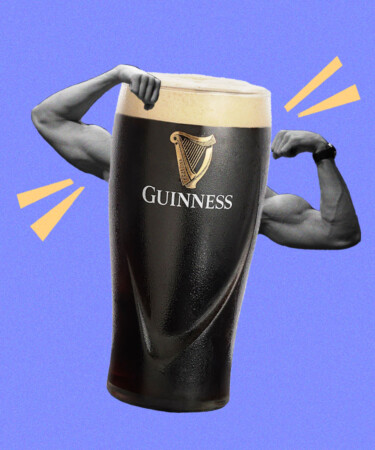Guinness is great, and there’s no debunking that. Over more than two centuries, it’s transformed from an Irish pub staple to a globally beloved pint. There’s a lot about Guinness we love, including its full-flavor, velvety texture, and rich, dark hue.
But many use these qualities to describe the classic brew as “heavy,” likening it to a so-called “meal in a glass.” Early Guinness slogans touted the beer as a strength-building brew that can wake you up and bolster your health. As it turns out, there are a lot of claims about Guinness that are widespread, yet far from the truth. Read on to get to the bottom of the most common myths about the stout.
It’s a meal in a glass.
Sure, Guinness does look pretty filling. It’s pitch black, leading one to believe that its contents might go down more like a milkshake than a traditional beer. But that’s not because it’s extra carb or calorie-dense — the color actually comes from the grain bill. Dark beers tend to employ more toasted or roasted barley and crystal malt, while lighter styles gravitate toward lighter malts, like pilsner malt. It’s a mere trick of the eye that the lighter in color a beverage is, the less filling we perceive it as visually, so it’s a no-brainer why Guinness appears hefty on sight.
And filling or not, Guinness is arguably a “light beer” calorie-wise. A 12-ounce pour of the stuff actually only packs 125 calories, which is 20 fewer than a Budweiser and only 15 more than a Bud Light. The same goes for Guinness’s ABV: 4.2 percent on draft, which is in line with Bud Light, too.
It makes you more bloated than other beers.
Guinness’s texture definitely has a weighted mouthfeel, but that’s not because it’s heftier than its counterparts. It simply comes down to the way it’s carbonated. Most beers are force-carbonated with CO2, giving them the same sharp, lively mouthfeel of any mass-market soda. Meanwhile, Guinness is carbonated with a 70/30 nitrogen-CO2 blend to mimic the creamy, low carbonation of cask-conditioned ales. Back when beer was exclusively held in casks made of wood, the carbonation had to stay relatively low, as casks didn’t have the structural integrity to withstand high pressure.
Every can of Guinness has a plastic widget inside that’s filled with more Guinness. The device, which was patented by the company in 1972, essentially resembles a small ping pong ball with a small hole on either side. Upon cracking a can of Guinness, the drop in pressure causes the contents of the widget to shoot out into the beer, thus agitating the liquid and causing a surge of bubbles that makes for the brew’s signature foamy head. On premise, Guinness (and all nitro beers) are dispensed via a specialized draught system that pumps nitrogen into a beer that’s already low in CO2. Given the fragility of the tiny bubbles a nitro pour yields, it must be done with care, hence the standardized two-minute pour time for a “proper” Guinness. When done right, those micro-sized bubbles will give the beer a smooth, creamy texture. That lower level of carbonation will inherently make the drinker less prone to bloating.
In fact, liquids don’t retain nitrogen as well as they retain CO2, so nitro beers actually go flat much faster than other brews. From the moment that Guinness makes its way from the tap and into your hand, there’s only a 30-minute window before that beer goes flat — and all those “bloating” bubbles are gone.
It’s Medicinal.
No beer fits the textbook definition of “healthy,” but there are some tiny threads of truth in the “Guinness is good for you” mantra. In 2003, a study at the University of Wisconsin examined the effects of lager versus Guinness on dogs with narrowed arteries. In layman’s terms, the dogs that consumed Guinness exhibited improved cardiovascular health and reduced artery clogging, while the dogs that drank lager experienced no such changes. Though admittedly not the most extensive or well-rounded study, it gave researchers reason to believe that Guinness can lower the risk of cardiac arrest and blood clots. This is presumably due to the fact that since Guinness is high in barley, it’s high in flavonoids: organic antioxidant compounds also found in red wine and dark chocolate that slow the buildup of cholesterol in the arteries. And given Guinness’s high unmalted barley content, it’s rather high in fiber in terms of beer. Most light beers don’t contain any, so Guinness is actually more beneficial to one’s digestive system than, say, a Bud Lite.
Guinness is also high in folate, a B vitamin that’s essential for producing DNA and other genetic material. That said, a pint of Guinness only packs 3.2 percent of the recommended daily intake of folate, so we wouldn’t call it a full-on perk. The same goes for Guinness’s iron content. There was a time when its perceived high iron content made it a doctor-recommended beverage for post-op patients, blood donors, and pregnant women. But once it became public knowledge that a pint only contains 1.1 milligrams of iron, or less than a tenth of the recommended daily intake for women, that theory went out the window.
So, while it might not be medicinal in a true sense, it’s no worse for you than any other beer on tap. We’ll take any excuse to sit down with a pint, because in the words of the brewery’s 1983 ad campaign, “Guinnless isn’t good for you.”
*Image retrieved from Mountain Ash Studio – stock.adobe.com
